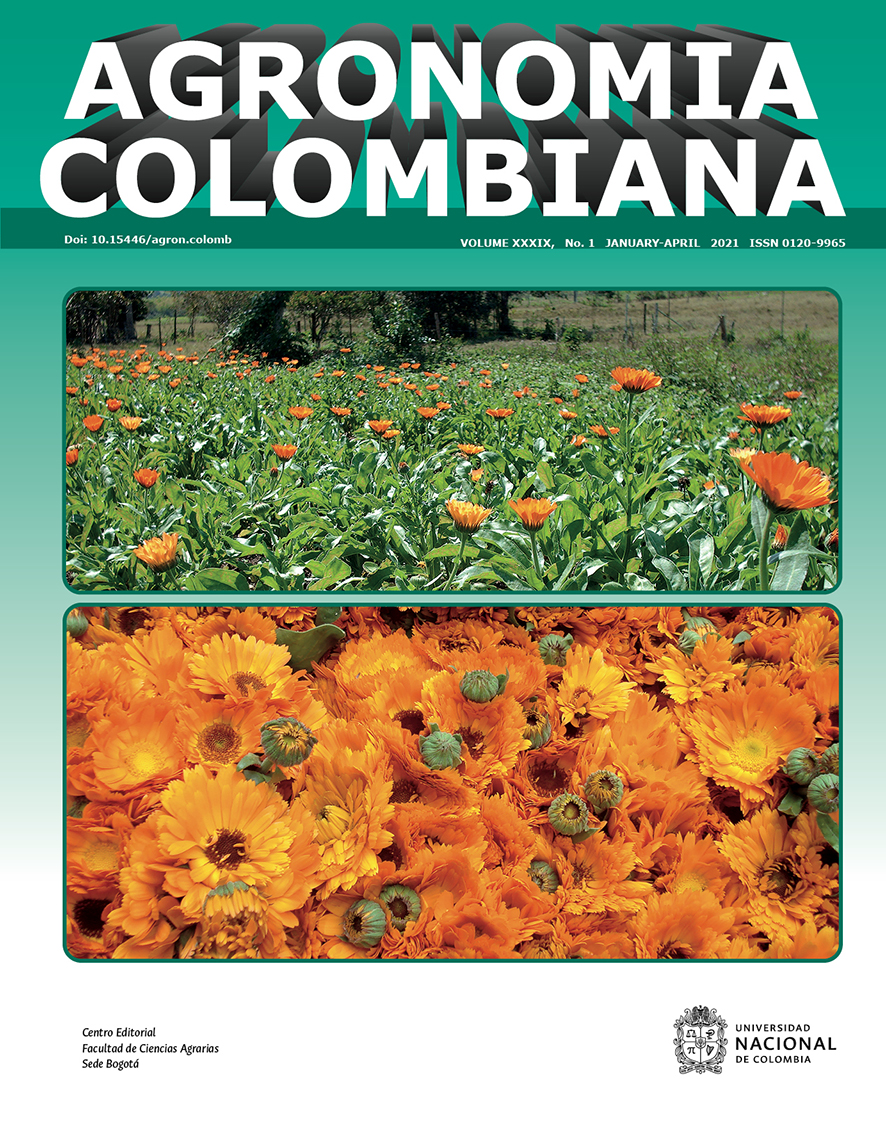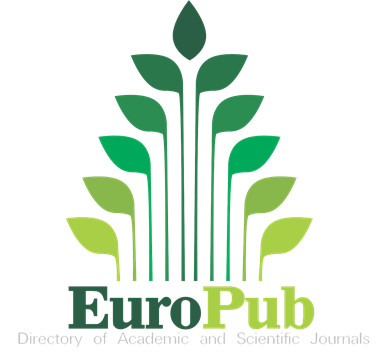Optimization of lactic acid production by Lactobacillus plantarum strain Hui1 in a medium containing sugar cane molasses
Optimización de la producción de ácido láctico por Lactobacillus plantarum cepa Hui1 en un medio que contiene melaza de caña
DOI:
https://doi.org/10.15446/agron.colomb.v39n1.89674Keywords:
fermentation, response surface methodology, by-products, industry (en)fermentación, metodología de superficie de respuesta, subproductos, industria (es)
Downloads
The aim of this study was to optimize lactic acid production by a native strain (Hui1) of Lactobacillus plantarum isolated from a Peruvian Amazon fruit (Genipa americana) in a medium supplemented with an agroindustrial by-product such as sugar cane molasses. Optimization was performed though one-factor-at-a-time studies followed by the Placket-Burman and central composite designs. The data were analyzed by using the Statistica® 10 software. Several carbon, nitrogen and ion sources were tested, and the optimum concentration of lactic acid achieved was 84.2 g L-1 in a medium containing as follows (in g L-1): meat extract, 18.69; tryptone, 7.88; sugar cane molasses, 140; calcium carbonate, 15; dipotassium phosphate, 1; manganese phosphate, 0.03; sodium acetate, 5, and magnesium sulphate, 0.2. In addition, a high degree of conversion from sugar cane molasses to lactic acid was obtained (Yp/s 0.898 g g-1). These results indicate the potential of Lactobacillus plantarum strain Hui1 to produce lactic acid in a medium supplemented with sugar cane molasses, an underutilized industrial by-product.
El objetivo de este estudio fue optimizar la producción de ácido láctico por una cepa nativa (Hui1) de Lactobacillus plantarum, aislada de un fruto de la Amazonía peruana (Genipa americana), en un medio suplementado con un subproducto agroindustrial como la melaza de caña de azúcar. La optimización se realizó mediante el estudio de un factor a la vez seguido de los diseños de Placket-Burman y compuesto central. Los datos se analizaron utilizando el software Statistica® 10. Se evaluaron varias fuentes de carbono, nitrógeno y iones, alcanzándose una producción de ácido láctico de 84.2 g L-1 en un medio que contenía (en g L-1): extracto de carne, 18.69; triptona, 7.88; melaza de caña de azúcar, 140; carbonato de calcio, 15; fosfato dipotásico, 1; fosfato de manganeso, 0.03; acetato de sodio, 5; y sulfato de magnesio, 0.2. Además, se obtuvo un alto grado de conversión de melaza de caña de azúcar a ácido láctico (Yp/s 0.898 g g-1). Estos resultados indican el potencial de la cepa de Lactobacillus plantarum Hui1 para producir ácido láctico en un medio suplementado con melaza de caña de azúcar, un subproducto industrial subutilizado.
References
Abedi, E., & Hashemi, S. M. B. (2020). Lactic acid production - producing microorganisms and substrates sources-state of art. Heliyon, 6(10), Article E04974. https://doi.org/10.1016/j.heliyon.2020.e04974
Alcántara, C., Coll, J. M., Jadán-Piedra, C., Vélez, D., Devesa, V., Zúñiga Cabrera, M., & Monedero, V. (2018). Polyphosphate in Lactobacillus and its link to stress tolerance and probiotic properties. Frontiers in Microbiology, 9, Article 1944. https://doi.org/10.3389/fmicb.2018.01944
AOAC. (2019). Official methods of analysis of AOAC international (21st ed.). AOAC International.
Behera, S. S., Ray, R. C., & Zdolec, N. (2018). Lactobacillus plantarum with functional properties: an approach to increase safety and shelf-life of fermented foods. BioMed Research International, 2018, Article 9361614. https://doi.org/10.1155/2018/9361614
Brinques, G. B., Peralba, M. D. C., & Ayub, M. A. Z. (2010). Optimization of probiotic and lactic acid production by Lactobacillus plantarum in submerged bioreactor systems. Journal of Industrial Microbiology and Biotechnology, 37(2), 205–212. https://doi.org/10.1007/s10295-009-0665-1
Chauhan, K., Trivedi, U., & Patel, K. C. (2007). Statistical screening of medium components by Plackett-Burman design for lactic acid production by Lactobacillus sp. KCP01 using date juice. Bioresource Technology, 98(1), 98–103. https://doi.org/10.1016/j.biortech.2005.11.017
Cheng, X., Dong, Y., Su, P., & Xiao, X. (2014). Improvement of the fermentative activity of lactic acid bacteria starter culture by the addition of Mn2+. Applied Biochemistry and Biotechnology, 174, 1752–1760. https://doi.org/10.1007/s12010-014-1156-z
Coelho, L. F., Lima, C. J. B., Rodovalho, C. M., Bernardo, M. P., & Contiero, J. (2011). Lactic acid production by new Lactobacillus plantarum LMISM6 grown in molasses: optimization of medium composition. Brazilian Journal of Chemical Engineering, 28(1), 27–36. https://doi.org/10.1590/S0104-66322011000100004
Coghetto, C. C., Vasconcelos, C. B., Brinques, G. B., & Ayub, M. A. Z. (2016). Lactobacillus plantarum BL011 cultivation in industrial isolated soybean protein acid residue. Brazilian Journal of Microbiology, 47(4), 941–948. https://doi.org/10.1016/j.bjm.2016.06.003
Correa Deza, M. A., Grillo-Puertas, M., Salva, S., Rapisarda, V. A., Gerez, C. L., & De Valdez, G. F. (2017). Inorganic salts and intracellular polyphosphate inclusions play a role in the thermotolerance of the immunobiotic Lactobacillus rhamnosus CRL 1505. PLOS One, 12(6), Article e0179242. https://doi.org/10.1371/journal.pone.0179242
Cubas-Cano, E., González-Fernández, C., & Tomás-Pejó, E. (2019). Evolutionary engineering of Lactobacillus pentosus improves lactic acid productivity from xylose-rich media at low pH. Bioresource Technology, 288, Article 121540. https://doi.org/10.1016/j.biortech.2019.121540
De Lima, C. J. B., Coelho, L. F., Blanco, K. C., & Contiero, J. (2009). Response surface optimization of D(-)-lactic acid production by Lactobacillus SMI8 using corn steep liquor and yeast autolysate as an alternative nitrogen source. African Journal of Biotechnology, 8(21), 5842–5846.
De Oliveira, R. A., Coelho, L. F., Bernardi, N. S., & Contiero, J. (2018). Experimental design for optimization of D-lactic acid production using a UV-light selected strain. Journal of Applied Biotechnology and Bioengineering, 5(4), 270–277. https://doi.org/10.15406/jabb.2018.05.00148
De Oliveira, R. A., Rossell, C. E. V., Venus, J., Rabelo, S. C., & Maciel Filho, R. (2018). Detoxification of sugarcane-derived hemicellulosic hydrolysate using a lactic acid producing strain. Journal of Biotechnology, 278, 56–63. https://doi.org/10.1016/j.jbiotec.2018.05.006
Dotaniya, M. L., Datta, S. C., Biswas, D. R., Dotaniya, C. K., Meena, B. L., Rajendiran, S., Regar, K. L., & Lata, M. (2016). Use of sugarcane industrial by-products for improving sugarcane productivity and soil health. International Journal of Recycling of Organic Waste in Agriculture, 5, 185–194. https://doi.org/10.1007/s40093-016-0132-8
Dumbrepatil, A., Adsul, M., Chaudhari, S., Khire, J., & Gokhale, D. (2008). Utilization of molasses sugar for lactic acid production by Lactobacillus delbrueckii subsp. delbrueckii mutant Uc-3 in batch fermentation. Applied and Environmental Microbiology, 74(1), 333–335. https://doi.org/10.1128/AEM.01595-07
Hwang, C. F., Chang, J. H., Houng, J. Y., Tsai, C. C., Lin, C. K., & Tsen, H. Y. (2012). Optimization of medium composition for improving biomass production of Lactobacillus plantarum Pi06 using the Taguchi array design and the Box-Behnken method. Biotechnology and Bioprocess Engineering, 17, 827–834. https://doi.org/10.1007/s12257-012-0007-4
Iorizzo, M., Testa, B., Lombardi, S. J., García-Ruiz, A., Muñoz-González, C., Bartolomé, B., & Moreno-Arribas, M. V. (2016). Selection and technological potential of Lactobacillus plantarum bacteria suitable for wine malolactic fermentation and grape aroma release. LWT - Food Science and Technology, 73, 557–566. https://doi.org/10.1016/j.lwt.2016.06.062
Komesu, A., Wolf Maciel, M. R., & Maciel Filho, R. (2017). Central composite experimental design applied to evaluate the lactic acid concentration by short path evaporation. Chemical Engineering and Processing: Process Intensification, 117, 89–94. https://doi.org/10.1016/j.cep.2017.03.020
Lew, L. C., Choi, S. B., Tan, P. L., & Liong, M. T. (2013). Mn2+ and Mg2+ synergistically enhanced lactic acid production by Lactobacillus rhamnosus FTDC 8313 via affecting different stages of the hexose monophosphate pathway. Journal of Applied Microbiology, 116(3), 644–653. https://doi.org/10.1111/jam.12399
Lew, L. C., Liong, M. T., & Gan, C. Y. (2012). Growth optimization of Lactobacillus rhamnosus FTDC 8313 and the production of putative dermal bioactives in the presence of manganese and magnesium ions. Journal of Applied Microbiology, 114(2), 526–535. https://doi.org/10.1111/jam.12044
Lino, F. S. O., Basso, T. O., & Sommer, M. O. A. (2018). A synthetic medium to simulate sugarcane molasses. Biotechnology for Biofuels, 11, Article 221. https://doi.org/10.1186/s13068-018-1221-x
Mousavi, Z. E., & Mousavi, M. (2019). The effect of fermentation by Lactobacillus plantarum on the physicochemical and functional properties of liquorice root extract. LWT - Food Science and Technology, 105, 164–168. https://doi.org/10.1016/j.lwt.2019.02.003
Mufidah, E., Prihanto, A. A., & Wakayama, M. (2017). Optimization of L-lactic acid production from banana peel by multiple parallel fermentation with Bacillus licheniformis and Aspergillus awamori. Food Science and Technology Research, 23(1), 137–143. https://doi.org/10.3136/fstr.23.137
Othman, M., Ariff, A. B., Rios-Solis, L., & Halim, M. (2017). Extractive fermentation of lactic acid in lactic acid bacteria cultivation: a review. Frontiers in Microbiology, 8, Article 2285. https://doi.org/10.3389/fmicb.2017.02285
Pacios, A., Cruz, Y., Bell, A., Carrera, E., & Michelena, G. (2009). Síntesis y caracterización del lactato ferroso para la fortificación de alimentos infantiles. ICIDCA, 43(1), 36–43.
Papizadeh, M., Rohani, M., Hosseini, S. N., Shojaosadati, S. A., Nahrevanian, H., Talebi, M., & Pourshafe, M. R. (2020). Screening for efficient nitrogen sources for overproduction of the biomass of the functionally probiotic L. plantarum strain RPR42 in a cane molasses-based medium. AMB Express, 10, Article 53. https://doi.org/10.1186/s13568-020-00976-x
Pejin, J., Radosavljević, M., Mojović, L., Kocić-Tanackov, S., & Djukić-Vuković, A. (2015). The influence of calcium-carbonate and yeast extract addition on lactic acid fermentation of brewer’s spent grain hydrolysate. Food Research International, 73, 31–37. https://doi.org/10.1016/j.foodres.2014.12.023
Rodríguez, J. A. (1987). Manual de prácticas de bioquímica (4th ed.). Universidad Autónoma de Nuevo León.
Safari, R., Motamedzadegan, A., Ovissipour, M., Regenstein, J. M., Gildberg, A., & Rasco, B. (2012). Use of hydrolysates from yellowfin tuna (Thunnus albacares) heads as a complex nitrogen source for lactic acid bacteria. Food and Bioprocess Technology, 5, 73–79. https://doi.org/10.1007/s11947-009-0225-8
Sengupta, S., Manna, S., Roy, U., & Das, P. (2020). Manufacturing of biodegradable poly lactic acid (PLA): green alternatives to petroleum derived plastics. Encyclopedia of Renewable and Sustainable Materials, 3, 561–569. https://doi.org/10.1016/b978-0-12-803581-8.11013-6
Sikder, J., Chakraborty, S., Sharma, V., & Drioli, E. (2014). Kinetic of lactic acid production from sugarcane juice using Lactobacillus plantarum NCIM 2912. Asia-Pacific Journal of Chemical Engineering, 9(3), 374–381. https://doi.org/10.1002/apj.1806
Sindhu, R., Gnansounou, E., Binod, P., & Pandey, A. (2016). Bioconversion of sugarcane crop residue for value added products - An overview. Renewable Energy, 98, 203–215. https://doi.org/10.1016/j.renene.2016.02.057
Singhvi, M., Zendo, T., & Sonomoto, K. (2018). Free lactic acid production under acidic conditions by lactic acid bacteria strains: challenges and future prospects. Applied Microbiology and Biotechnology, 102, 5911–5924.
Solval, K. M., Chouljenko, A., Chotiko, A., & Sathivel, S. (2019). Growth kinetics and lactic acid production of Lactobacillus plantarum NRRL B-4496, L. acidophilus NRRL B-4495, and L. reuteri B-14171 in media containing egg white hydrolysates. LWT - Food Science and Technology, 105, 393–399. https://doi.org/10.1016/j.lwt.2019.01.058
Srivastava, A. K., Tripathi, A. D., Jha, A., Poonia, A., & Sharma, N. (2014). Production, optimization and characterization of lactic acid by Lactobacillus delbrueckii NCIM 2025 from utilizing agro-industrial byproduct (cane molasses). Journal of Food Science and Technology, 52, 3571–3578. https://doi.org/10.1007/s13197-014-1423-6
Sun, Y., Xu, Z., Zheng, Y., Zhou, J., & Xiu, Z. (2019). Efficient production of lactic acid from sugarcane molasses by a newly microbial consortium CEE-DL15. Process Biochemistry, 81, 132–138. https://doi.org/10.1016/j.procbio.2019.03.022
Tong, Y., Zhai, Q., Lu, W., Tian, F., Zhao, J., Zhang, H., & Chen, W. (2017). New insights in integrated response mechanism of Lactobacillus plantarum under excessive manganese stress. Food Research International, 102, 323–332. https://doi.org/10.1016/j.foodres.2017.10.014
Tripathi, A. D., Srivastava, S. K., Singh, P., Singh, R. P., Singh, S. P., Jha, A., & Yadav, P. (2015). Optimization of process variables for enhanced lactic acid production utilizing paneer whey as substrate in SMF. Applied Food Biotechnology, 2(2), 46–55. https://doi.org/10.22037/afb.v2i2.7612
Unban, K., Kanpiengjai, A., Khatthongngam, N., Saenjum, C., & Khanongnuch, C. (2019). Simultaneous bioconversion of gelatinized starchy waste from the rice noodle manufacturing process to lactic acid and maltose-forming α-amylase by Lactobacillus plantarum S21, using a low-cost medium. Fermentation, 5(2), Article 32. https://doi.org/10.3390/fermentation5020032
Yang, P. B., Tian, Y., Wang, Q., & Cong, W. (2015). Effect of different types of calcium carbonate on the lactic acid fermentation performance of Lactobacillus lactis. Biochemical Engineering Journal, 98, 38–46. https://doi.org/10.1016/j.bej.2015.02.023
Zhang, Y., & Vadlani, P. V. (2015). Lactic acid production from biomass-derived sugars via co-fermentation of Lactobacillus brevis and Lactobacillus plantarum. Journal of Bioscience and Bioengineering, 119(6), 694–699. https://doi.org/10.1016/j.jbiosc.2014.10.027
How to Cite
APA
ACM
ACS
ABNT
Chicago
Harvard
IEEE
MLA
Turabian
Vancouver
Download Citation
CrossRef Cited-by
1. Nur Izzah Nabilah Haris, Shanti Faridah Salleh, Cirilo Nolasco‐Hipolito, Awang Ahmad Sallehin Awang Husaini, Mohd Hafizz Wondi, Nur Haninah Harun, Nurliyana Abdul Raof. (2025). A review on lactic acid production via microbial fermentation from biowaste: insights on scaling up to industrial process. Biofuels, Bioproducts and Biorefining, 19(2), p.437. https://doi.org/10.1002/bbb.2704.
2. Dailyn Sosa-Cossio, Yaneisy García-Hernández, Julio C. Dustet-Mendoza, Maryen Alberto Vázquéz, Nereyda Albelo-Dorta, Dania Ortega-de-la-Paz. (2025). Diseño de medios de cultivo para el crecimiento de Lactobacillus pentosus LB-31 como probiótico para la producción animal. Revista U.D.C.A Actualidad & Divulgación Científica, 28(1) https://doi.org/10.31910/rudca.v28.n1.2025.2644.
3. D.I. Kiiv. (2025). COMPREHENSIVE EVALUATION OF THE BIOSYNTHETIC POTENTIAL OF Lactobacillus delbrueckii STRAINS IN LACTIC ACID SYNTHESIS. Biotechnologia Acta, 18(5), p.43. https://doi.org/10.15407/biotech18.05.043.
4. Dipayan Das, Meisithuiliu Riamei, Payel Paul, Niraj Singh, Birson Ingti, Reema Dey Sarkar, Ruvelu Rose, Pankaj Losan Sharma, Susmita Paul. (2025). Understanding the role of soil microorganisms in alleviating hydric and edaphic stress towards sustainable agriculture. Discover Soil, 2(1) https://doi.org/10.1007/s44378-025-00076-x.
Dimensions
PlumX
Article abstract page views
Downloads
License
Copyright (c) 2021 Agronomía Colombiana

This work is licensed under a Creative Commons Attribution-NonCommercial-ShareAlike 4.0 International License.
© Centro Editorial de la Facultad de Ciencias Agrarias, Universidad Nacional de Colombia
Reproduction and quotation of material appearing in the journal is authorized provided the following are explicitly indicated: journal name, author(s) name, year, volume, issue and pages of the source. The ideas and observations recorded by the authors are their own and do not necessarily represent the views and policies of the Universidad Nacional de Colombia. Mention of products or commercial firms in the journal does not constitute a recommendation or endorsement on the part of the Universidad Nacional de Colombia; furthermore, the use of such products should comply with the product label recommendations.
The Creative Commons license used by Agronomia Colombiana journal is: Attribution - NonCommercial - ShareAlike (by-nc-sa)

Agronomia Colombiana by Centro Editorial of Facultad de Ciencias Agrarias, Universidad Nacional de Colombia is licensed under a Creative Commons Reconocimiento-NoComercial-CompartirIgual 4.0 Internacional License.
Creado a partir de la obra en http://revistas.unal.edu.co/index.php/agrocol/.




















